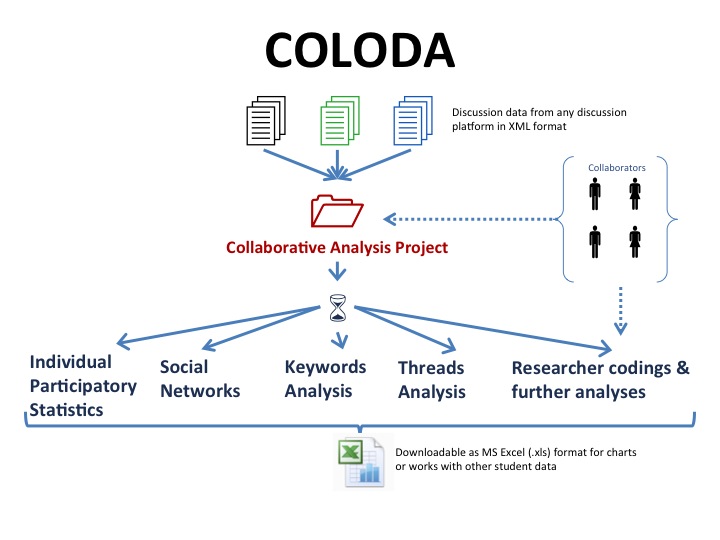How teachers assess KB outcomes
Knowledge building through online discussion requires much effort to both follow and evaluate, in preparation for the next step. However, teachers are very busy and often do not have time to read every note contributed to the KB forum. How might they fulfil the requirements of KB?
There are several “layers” to a typical Hong Kong teacher’s concerns:
- Promoting good KB practices:
- Are students participating in the online discourse?
- Are there students who made zero participation?
- Insights on pedagogical design:
- Do ideas progress in the online discourse?
- Can students raise idea progressing questions?
- What’s the theme of the discussion threads?
- Are there notes with potential for further development?
- Which aspect of the discussion can be further improved?
- Further goals:
- Is there any advancement in my students over 1 or 2 years of KB activities, in terms of question framing, evaluating and summarising ideas, as reflected from their contributions to the online discourse?
Below is a table that provides suggestions for assessment methods and criteria to help teachers assess how far students have achieved at different stages of the knowledge building process.
| Key Pedagogical Focus | Suggested Assessment Criteria | How to Assess | Illustrative Videos & Presentations |
|
Generate inquiry questions |
Are students contributing their inquiry questions? |
An example of how a primary school Chinese teacher encourages his students to raise questions on the topic of "Hong Kong Kids": |
|
| Identify good questions for inquiry |
What is a good question?
Basic level questions VS High level questions Basic level questions
High level questions
Depth of inquiry
Rating scheme:
2. Questions asking for factual, topical and general information 3. Questions identifying specific gaps and asking for open-ended responses and different viewpoints 4. Explanation-based questions - Focus on problems not topics; identify sources of inconsistencies; generate conjectures and possible explanations |
Qualitative methods
|
How to use rating scheme to assess depth of inquiry questions: |
| F2F and online discussion |
Are students participating in the discussion?
Are students linking and expanding ideas?
|
Quantitative methods
|
|
| Identify good discussion |
What is a good discussion?
Criterion 1: Use of authoritative sources & thinking critically
Criterion 2: Evidence of democratizing knowledge, idea diversity
Criterion 3: Evidence of idea improvement
Criterion 4: Review & reflect regularly for idea progressions and inquiry process
|
Qualitative methods
|
How to assess notes and discussions: |
| Consolidation |
What is a good reflection?
What is a good summary note?
What is a good electronic portfolio? Criterion 1: Working at the cutting edge
Criterion 2: Progressive problem solving
Criterion 3: Collaborative effort
Criterion 4: Monitoring own understanding
Criterion 5: Constructive uses of different sources of information
|
Qualitative methods
|
How to assess reflective learning journal, summary note, group review and electronic portfolio: |
Technological support for assessing KB
Assessment technologies have been developed to provide teachers and students with useful information about their knowledge building process. Currently, there are three main technologies used in assessing KB outcomes:
- Analytic Toolkit (ATK)
- Applet Tools on Knowledge Forum
- Collaborative Online Discourse Analyzer (COLODA)
Analytic Toolkit (ATK)
The Analytic Toolkit provides summary statistics on activity in Knowledge Forum. It gives an overview of a particular Knowledge Forum database, summary and individual statistics of use of specific features, specific activity logs, analyses of social interactions as well as analyses of note and database history.
Below are a video and a presentation illustrating how to generate ATK statistics.
For examples of how to interpret ATK statistics, please click here.
IKIT has created a reference page explaining the calculation of ATK measures. Click here for the reference page.
Applet Tools on Knowledge Forum
Applet tools also helps analyze different aspects of activity in Knowledge Forum. Unlike ATK, applet tools provides graphical representation of the statistics. Also, applet tools are integrated into KF, so interested students can generate participatory statistics on their own.
Below are a video and a presentation illustrating how to run applet tools on KF.
Collaborative Online Discourse Analyzer (COLODA)
The Centre for Information Technology in Education at the University of Hong Kong, in collaboration with the Research Center of Knowledge Engineering at Beijing Normal University, has developed a pedagogical and assessment tool to assist called the Collaborative Online Discourse Analyzer (COLODA).
COLODA can help tackle the following challenges:
- Are students learning? What have they learnt?
- Are students knowledge building? At what level?
- Building on research literature or discourse analysis to provide quick overview for teachers:
- Levels of engagement
- Differences in engagement among students
- Patterns of interaction
- Help teachers to adjust their facilitation
- Help to build knowledge about KB pedagogy
- Facilitate sharing of expertise among teachers
COLODA's functions include:
- Offer summaries and overviews about the discussions
- Provide numerous displays and analyses automatically for researchers
Outputs from the analyses can be organized into different levels:
- Individual students
- Notes
- Discussion threads
- Discussion views
- Date or week
Real examples of assessing KB outcomes
In the "How do teachers design KB lessons" section, we have included several detailed pedagogies of three teachers. In which, apart from introducing the designs of Mr Wong and Ms Tse, we have listed some graphs which illustate the analyses explained int he above and the students’ learning outcomes. Click here for Mr Wong’s students’ learning outcomes. Also, Click here for Ms Tse’s students’ learning outcomes.






